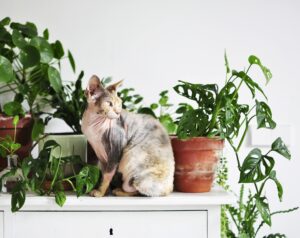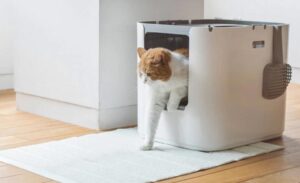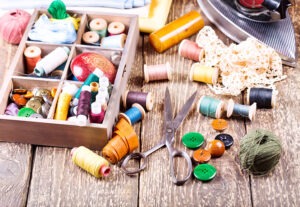Cats are great pets, and they are very curious animals. Because of this, the best way to protect your cat and family is to cat-proof your home before bringing one home.
Table of Contents
Move Your House Plants

If you have house plants in your home, it is a good idea to put them in a room that your cat won’t have access to or get rid of them altogether.
Many cats will try to dig in the pots, tossing dirt all over the house. This can be messy and frustrating. They also like to chew on plants, which is dangerous if you have house plants that are poisonous to cats. The most common toxic plants include:
- Daffodils
- Autumn Crocus
- Hyacinth
- Azaleas
- Tulips
- Lilies
- Rhododendrons
- Oleander
- Cyclamen
- Foxglove
If you leave these pets around the house and your cat chews on them, it can cause lethargy, vomiting, and death.
Secure Your Valuables
If you keep breakable valuables around the house, such as fine china and expensive sculptures or expensive nik naks, or anything of sentimental value, you should move them to a secure place before bringing your cat home.
Cats are very curious creatures, and they can jump up on most surfaces. If your cat gets too close to your breakables, it won’t be long before they come crashing down on the floor.
To protect your valuables and keep from getting upset with your new pet, it is best to move these objects.
Secure All Blind Electrical Cords
Cats love to chew on objects. This is especially true with kittens. If you are like most people, you have plenty of electrical cords on the floor, which will be very appealing to your cat. If your cat chews through an electrical cord that is plugged in, they can get electrocuted.
Before bringing your cat home, you should unplug anything that isn’t being used. You can also use cord protectors that your cat won’t be able to chew through. These are great because they will protect your cat and your electrical devices.
You should also secure your blind cords. They will look like toys to your cat, and your cat can pull them down. While trying to play, your cat can get tangled in the blind cord, which can result in serious injury and even death.
Secure Your Screens

One of a cat’s favorite places to sit is on the windowsill. Many cats love to look out the window and watch what is going on.
Before you bring your cat home, it is essential that you check all of your screens to be sure that they are secure. If they aren’t, your cat can slip out the window, and it can be difficult to find them. If your cat is sitting in a second-floor window and they slip out, they can be seriously injured.
Provide Scratching Posts

Cats have an instinctive need to scratch. They do this so they can file their nails and keep them sharp. If you don’t provide your cat with scratching posts, they will scratch your walls, doors, and furniture.
If your cat scratches deep enough, they can get splinters. Also, all of this scratching can cause damage to your home and belongings.
It is best to have a scratching post on every floor of your home.
The Litter Box

Cats are very clean animals, and they prefer a clean litter box. It is best to clean your cat’s litter box daily. This will prevent them from going to the bathroom outside of the litter box and from getting a bacterial infection from the dirty litter.
If your cat will have access to multiple floors in your home, it is best to have one cat litter box on every floor. This will protect your cat and your home.
Keep Your Sewing Kit Out Of Sight

When you see a cat in a cartoon, they are usually playing with a ball of yarn. This might look cute in the cartoons, but it can be very dangerous for your cat. String, thread, and yarn can get wrapped around your cat’s tongue, which can be very dangerous. If your cat swallows these objects, they can get wrapped around your cat’s intestines.
To keep your cat safe, you should keep any thread, yarn, and string out of sight and give your cat safer toys to play with.
Keep Your Food Out Of Reach

When you bring your cat home, you don’t want to leave plates of food lying around. It would be best if you also kept an eye on your cat while you are cooking. It is not uncommon for a cat to eat human food, and some types of food are toxic to cats. These include:
- Onions
- Garlic
- Chocolate
- Raw dough
- Milk and other dairy products
- Grapes
- Raisins
- Alcohol
Watch Out For Hot Surfaces
Cats love to jump up on the counter and other high surfaces to explore. If you have a cooktop, your cat can burn the sensitive pads on its paws. After cooking, you should leave a pan of water over the hot burners until they cool down. If your cat goes outdoors and you are cooking on the grill, be sure to close the cover until the grill cools down.
Watch Where You Light Candles
If you often light candles to keep your home smelling fresh, you need to watch where you put them when your cat is around. If your cat jumps up on a table too close to the candle, they can knock it off, potentially causing a fire. Your cat can also get too close, causing them to burn its tail.
It is best to keep your candles in areas where your cat is unable to get to.
Your new cat won’t understand the dangers inside and outside of your home. Therefore, it is up to you to keep them safe. Before bringing your cat home, you should follow the catproofing tips listed above. Catproofing your home will ensure a long and happy life with your new four-legged friend.

